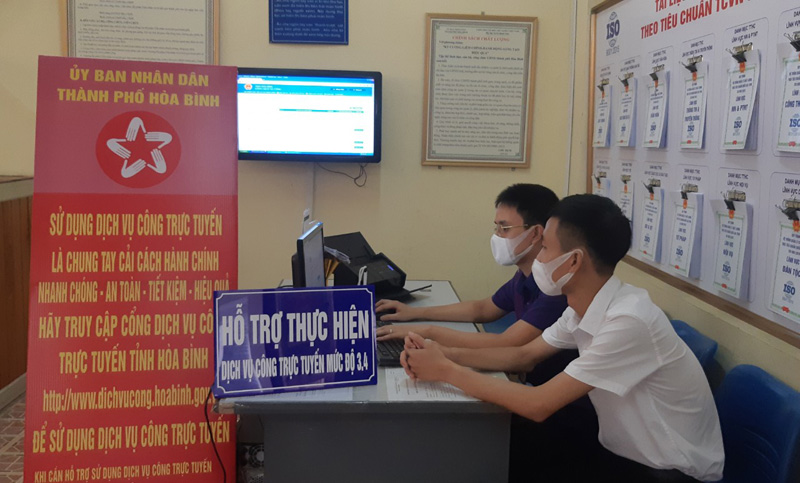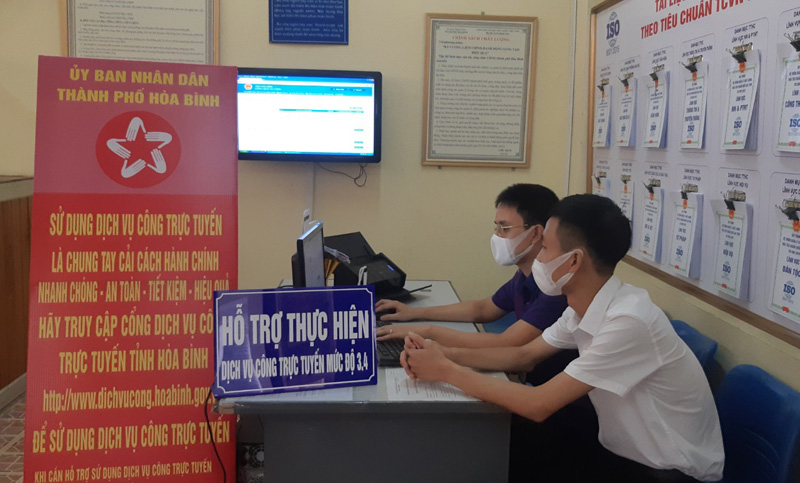
(HBO) - During its development process and the 2015-2020 tenure, Hoa Binh city has affirmed its role and position as a political, administrative, socio-economic and cultural centre and a driver for economic growth of the province. With a high political determination, the city’s Party organisation has focused on directing the successful implementation of targets and missions set by its previous congress.
 Hoa Binh city speeds up administrative
reform.
Hoa Binh city speeds up administrative
reform.
The merger of Ky Son district with Hoa Binh
city is a strategic mission helping the city to develop further. After the
merger, the city has 10 urban wards and nine rural communes. Its apparatus and
personnel contingent have been consolidated, and urban areas have recorded
important changes. The economic structure has shifted along the set direction,
with the services, industry and construction sectors accounting for 92.7
percent, and the agro-fishery-forestry sectors only 7.3 percent. State budget
collection in 2020 is estimated at 580 billion VND, per capita income at 70
million VND, and the poverty rate reduces to 1.47 percent. At present, seven
out of nine rural communes have been recognized as new-style rural areas. The
city is striving to have Hop Thanh commune earn the title of advanced new-style
rural area and Yen Mong commune a model new-style rural area within this year.
In the first nine months of this year, the
city focused on mobilising resources to work on the dual targets of COVID-19
prevention and control and socio-economic development. Many targets have been
fulfilled or surpassed, including total retail sales and services revenue
exceeding 12.5 trillion VND, up 16 percent year on year and fishery output
reaching nearly 1,000 tonnes, up 11 percent. The yearly targets on State budget
collection, job creation and afforestation have already been completed.
The achievements have created a foundation
and momentum for the city’s development in the next period towards the goal of becoming
a tier-II urban area before 2025. The city is taking measures to carry out the
resolution of its Party organisation congress./.
Hoa Binh province is undergoing a dynamic transformation amid Vietnam’s national digital transition. Building on Poliburo’s Resolution No. 57-NQ/TW on breakthroughs in science, technology, innovation, and national digital transformation, the province has rolled out a wide range of practical action plans. A standout initiative is the "Digital Literacy for All” movement, an effort to ensure that no one is left behind in the digital era.
Hoa Binh province is undergoing a dynamic transformation in the wake of the national digital transformation movement. Building on Resolution No. 57-NQ/TW of the Politburo on breakthroughs in science, technology, innovation, and national digital transformation, the province has implemented a wide range of practical action plans. A standout initiative is the "Digital Literacy for All” movement ambitious effort to ensure that no one is left behind in the digital age.
With a spirit of unity and proactive problem-solving, the Party Committee, the government and the people of Dong Lai Commune (Tan Lac District) have made great strides in implementing the resolutions of the 24th Party Congress of the commune for the 2020 - 2025 term. Focusing on leadership and practical actions, the commune has brought the Party’s resolutions into daily life, creating strong impacts and pushing the local development forward.
Amid the nationwide push for digital transformation, young people in Hoa Binh Province are stepping up as dynamic pioneers, applying technology to enhance Youth Union operations and expand the reach of youth-led initiatives. Through creativity and adaptability, Youth Union organizations at all levels have introduced a series of practical solutions, contributing to modern governance and community development.
In recent years, An Nghia commune, located in Lac Son district, has stepped up administrative reform, focusing on improving the quality and efficiency of its single-window service unit for receiving and processing administrative procedures. These improvements have helped create favourable conditions for local residents and organisations to handle administrative procedures, contributing to the commune’s broader socio-economic development.
The Prime Minister-approved master plan to develop the multi-use value of forests ecosystems through 2030, with a vision to 2050, aims to improve the management and sustainable use of forest resources, create jobs, increase incomes, and improve the living standards of ethnic minorities, people in mountainous and remote areas, forest workers and those living near forests.



 Hoa Binh city speeds up administrative
reform.
Hoa Binh city speeds up administrative
reform.